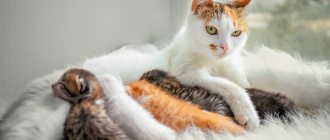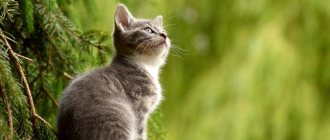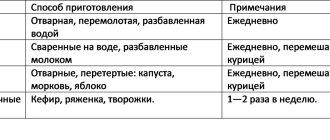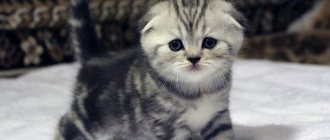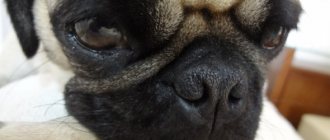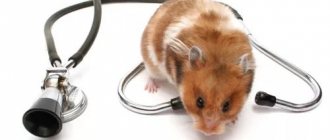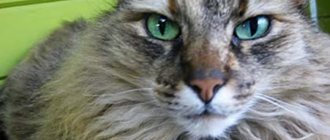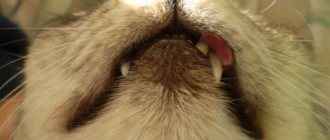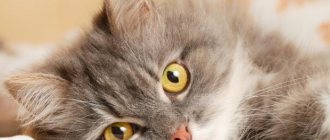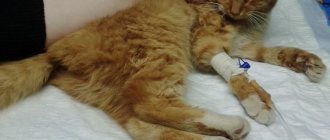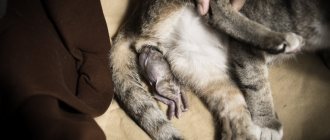Even the most caring owner's cat can get sick. The Scottish Fold is no exception. Veterinarians identify several pathologies characteristic of the breed. Owners should do their research to be on the lookout. Diseases of Scottish Fold cats - what they are, their characteristics, main symptoms - read all this in our article.
Diseases of Scottish Fold cats
Breed health features
It is generally accepted that Scottish cats have strong immunity and rarely get sick. However, this rule applies only to straight-eared representatives of the Scottish Straight. Scottish Folds with fold ears are much more prone to illness.
Problems with folds are due to the origin of the species. Ears bent to the skull with tips pointing forward appeared as a result of a mutation of the straights. The altered gene simultaneously affects the development of bones, eyes, and the structural structure of the auditory shells. With repeated crossing of lop-eared animals, the likelihood of pathologies in the offspring increases. Therefore, mating is always done with straight-eared cats. Such crossing reduces the possibility of getting a genetic disease, but it is still impossible to completely eliminate the negative gene.
Hereditary anomalies entail a general instability of the cat's body to various kinds of ailments and contribute to the development of side diseases. Cats cannot treat themselves, so it is necessary to monitor your pet.
Hereditary anomalies lead to general weakening and contribute to the development of side diseases
Experts have identified the following fold risk areas:
- bones;
- blood;
- eyes;
- leather;
- ears;
- internal organs;
- teeth.
Scottish Straight food
Proper nutrition plays an extremely important role in a cat's health. It should be regular in time of day, portion size and variety of food. The Scottish Straight's diet must include a variety of foods, such as cereals, vegetables and some fruits.
Feeding your pet exclusively dry food will never do any good. The cat needs to set a clear portion size. Eating too much will only add to the bigger problem of obesity.
All cats should be given dairy products: cottage cheese or kefir. You should not abuse higher-fat dairy products. After all, their frequent use can negatively affect the health of your pet.
Scottish straights are very fond of natural offal (heart, liver). They enjoy eating lamb, chicken, beef or turkey. You shouldn't give pork to a Scot. The cat eats only sea fish, boiled. It is best to remove large bones before feeding.
Genetic diseases of Scottish cats
There are 2 pathologies identified in this category:
- osteochondrodystrophy;
- hemophilia type B.
Osteochondrodystrophy is expressed in a deformed skeleton and arthritis that appears against this background. Mainly, these include curved front and rear limbs, an overly thick tail, and poorly developed cartilage tissue. It is impossible to cure the disease. Throughout the life of the cat, maintenance therapy is provided, but over time, paralysis occurs.
Osteochondrodystrophy on x-ray
An equally terrible result of gene mutation was B-type hemophilia . In individuals, blood clotting is impaired, bleeding increases when the integrity of the body's integument is violated. Often the problem remains a mystery until surgery or lacerations. A protective crust does not form on the damaged area. Lack of fibrin prevents bleeding from being blocked. It is not possible to save the animal in every case.
On a note! The best prevention of terrible genetic abnormalities is compliance with breeding rules.
Osteochondrodystrophy in a cat
Eye diseases
They are divided into two groups.
Table 1. Types of eye diseases
| Congenital | Purchased |
| Eversion (inversion) of eyelids, photosensitivity | Infections, cataracts, glaucoma |
Congenital are associated with the structure of the skull. The skin covers the muzzle in such a way that one or both eyelids may turn out. The ciliary edge begins to touch the eyeball, constantly irritating it and causing pain. Without treatment, the pupil can be damaged to the point of blindness. A poorly covered eye reacts sharply to too aggressive light. It is contraindicated for Scottish Folds to be in rooms with fluorescent devices. Wide-open eyes need more gentle, soft lamps.
The problem of the structure of the eyelid can only be corrected surgically. If the pet experiences only mild discomfort, prevention is sometimes suggested with regular rinses, drops, or eye ointments.
Acquired eye pathologies are also associated with the structure of the eyelid, but arise due to an infection. The mucous membrane of the Scottish Fold has little protection, so any dirt can lead to infection with conjunctivitis, keratitis, and blepharitis . Especially often, trouble occurs in childhood, when the immune system is not yet formed.
The mucous membrane of the Scottish Fold cat has little protection, so any dirt can lead to infection
Glaucoma and cataracts appear gradually. They can go unnoticed for a very long time. With glaucoma, the pressure inside the eye increases and the eye begins to swell and enlarge. Cats with cataracts suffer from clouding of the lens. Both cases can result in complete blindness. Veterinarians recommend checking your pet's vision at least once every six months. This is the only way to identify structural changes in time.
Third eyelid disease in cats
Read more about eye diseases in cats in a special article on our portal.
Ear diseases
Congenital ear problems are rare. Usually they are expressed in an underdeveloped internal part or its irregular shape. In this case, the shell is simply not adapted to perceive sounds, and it cannot be corrected. In addition, lop ears contribute to the accumulation of dirt in the sink. Against this background, an infection may develop. Otitis media and tumors reduce the cat's hearing. In the advanced version, complete deafness occurs. Treatment is carried out using injections, local drops, and ointments.
How to care for a sick cat?
How it works
Due to their activity and playfulness, folds are ready to spend hours hunting and tinkering with feather teasers and mouse imitators. In games, they hone their movements, improve their dexterity and reaction. Observing the actions of the animal, you might think that it will act in the same way if a hamster or other small living creature gets into its tenacious paws. However, cats, thanks to their level of intelligence, perfectly distinguish the status of other animals: pets (parrots, fish, hamsters, purebred rats) will not become victims of the hunting habits of the Scottish cat. He views them as full members of the domestic pack. Of course, a young cat will not fail to hurry up her “younger brother”, but she will not allow herself to use her teeth at full speed; she may bite lightly, push with her paw, but only for the sake of play. Tracking and sneaking are interspersed with short attacks on the “victim”, lightly pressing him to the floor, and then the whole process can be repeated again.
Most often, cats are owned by families with children . Parents need not be afraid that the Scot will scratch their child. If the child behaves correctly, the baby animal will never provoke an unpleasant situation. Scottish is an ideal participant in fun games. In some situations, he can behave like a patient nanny , who strives to keep his restless ward occupied with something, allowing him to do things unthinkable for the cat’s mind - spoon-feed himself, dress him in various outfits, turn into a horse for dolls . The cat likes to play hospital, he happily turns into a patient, allows him to examine his paws, give him a massage, lay him on his back, listen with a stethoscope, the main thing is that it doesn’t come down to injections. In joint games, both kids get used to interacting and listening to each other’s feelings. The child learns to care for an animal and sees it as a friend.
The Scottish Fold can confidently be considered a companion cat. The animal will happily share both leisure time and housework with its owner. Do you need help “working” on the computer, “doing” homework, “cooking” dinner? - The kitty will have time to go everywhere. He feels especially confident in his role as a taster of all dishes prepared in the kitchen. Only a Scot on quiet evenings can sit so peacefully and comfortably next to the owner while he reads a book or watches TV. The tact of the animal will not allow it to interrupt the morning sleep of its patron and his household with a wild prank.
Skin diseases
Skin lesions in Scottish Folds are almost always found in conjunction with immune disorders, nervous disorders and diseases of the internal organs. The list includes:
- Demodecosis. Skin mites settle on animals in conditions of unsanitary conditions and nutritional deficiency. Small kittens weakened by diseases and anthelmintic drugs are especially susceptible. Spots, sores, and irritations appear on the body.
- Scabies. Occurs due to nervousness due to infection with parasites or as a result of an allergy to shampoo, food or other external irritant. Along with external influences with creams and lotions, it is necessary to treat the original cause, eliminate ticks, fleas, and the source of the allergy.
- Eczema. External manifestation of malfunction of internal organs - digestive disorders, infection with worms, oncology, endocrine problems.
Manifestation of skin diseases in cats
Attention! Skin diseases are similar to each other, and you cannot do without a medical diagnosis.
Prevention, nutrition, healthy lifestyle
Already at the stage of choosing a kitten, you can take care of preventing diseases in your future pet . So, in order to avoid choosing a kitten with a predisposition to osteochondrodysplasia, it is advised not to give preference to individuals with too hard (inflexible) paws and an inactive tail. Also, crossing lop-eared animals with each other is undesirable due to the dominance of the lop-eared gene, which can cause very serious bone and cartilage diseases in the offspring.
It should be remembered that due to a sedentary lifestyle with diseases of the musculoskeletal system and limbs, the food should also be adjusted to prevent the animal from gaining excess weight or obesity. On the other hand, food should contain additives that prevent fractures and joint destruction. Daily hygiene of the cat’s vision and hearing organs, skin and fur will help to avoid serious problems with the condition of these organs and promptly identify deviations from the norm, which are easier to correct.
Balanced food plays an important role in the harmonious development of the Scottish Fold and its health. A sufficient, but not excessive, amount of mineral and vitamin supplements will help the owner correct the vulnerable condition of the pet, and the correct ratio of the various energy components of the food will help to avoid problems with the digestive system, as well as with other organs of the animal.
Another important point in preventing diseases of Scottish Folds is vaccination, which should not be neglected even by those whose pets rarely or do not walk outside at all, since the infection can be brought into the home from the outside. Vaccination must be timely, that is, carried out within a certain time frame, with the frequency specified by specialists.
Important! This also applies to the fight against parasites (worms, ticks, fleas, etc.) - periodic measures to prevent their spread will save money for the owner and vitality for the pet.
To prevent diseases of the kidneys and urinary tract of the Scottish Fold, a balanced diet containing all the necessary minerals and additives, but in the required quantity, without excess, is mandatory. Thermal conditions are also important - both overheating and hypothermia are undesirable . The animal must have constant access to quality drinking water.
An active lifestyle for a cat (as far as possible given its state of health) will help prevent illness and maintain its vitality. Cats should receive a sufficient amount of physical activity - this will help to avoid many diseases associated with the animal’s sedentary lifestyle: obesity, excess weight, diabetes, constipation, which, in turn, can cause more significant harm to the pet’s health.
Pathologies of internal organs
The list of possible diseases of internal organs is very extensive. Most often, owners of Scottish Folds come to the veterinarian with the following problem areas:
- heart: failure, arrhythmia, often associated with hemophilia;
- digestion: inflammation of the stomach, intestinal obstruction, liver disease, accompanied by infectious and parasitic infections, allergies, poisoning with poor-quality food;
- immunity: colds, viral diseases;
- genitourinary system: urolithiasis (urolithiasis), cystitis. Read about kidney diseases
Attention! None of the points can be diagnosed and treated without the participation of a doctor. Many face death without timely help.
Video - Diseases of joints and bones in cats
Symptoms
The first thing you need to pay attention to is the general condition and mood of the cat. An unhealthy Scottish Fold will be characterized by lethargy, apathy, lack of appetite, sometimes irritable reactions and unreasonable aggression. The nose becomes dry and very hot to the touch. Perspiration may appear on the fur. When measuring temperature, the readings will exceed 38.5 °C.
On a note! A dry nose in hot weather and after sleep is a variant of the physiological norm. Under such conditions, the signs most likely will not indicate illness.
An unhealthy Scottish Fold will be lethargic, apathetic, and lack of appetite.
In specific diseases, the cat owner can focus on the symptoms.
Table 2. Symptoms of diseases of internal organs
| Type of disease | First symptoms |
| Viruses | Sneezing, discharge from mouth and nose, fever |
| Ear | The cat shakes its head, discharge from the ears (pus, fluid), putrid smell from the shells, redness of the skin in the shells, the cat scratches its ears |
| Ophthalmic | Redness, lacrimation, purulent discharge, swelling of the eyelids of varying degrees, the cat tries to scratch the eyes, poor orientation in space, cloudy pupils |
| Digestive | Refusal to eat, vomiting, nausea, constipation, diarrhea, undigested pieces in feces, increased thirst |
| Skin | Scabies, redness, bald patches, rashes, sores, blisters, peeling, nodules |
| Heartfelt | Shortness of breath, cough, swelling, increased frequency of sighs, low temperature, fainting |
| Genitourinary system | Sudden weight loss, pink urine, apathy, frequent urination, the cat meows when urinating, fussing |
| Bone | Disproportionately large head, crooked, protruding jaw, shortened limbs, curvature of the spine, twisted front legs, joints with a swollen effect, too massive joints, growths on them, slow or absent growth of the cat, shortened thick tail, inactivity, clumsiness of movements, attempts not to bend the paws when moving |
| Dental | Foam, pus, excessive drool from the mouth, bad odor from the mouth, yellow, brown, gray growths on the teeth, brittle teeth, refusal to eat (it hurts to eat) |
In the early stages, 2-3 mild symptoms may be observed. As the pathology develops, the number of manifestations increases. It is necessary to monitor your fold ear and consult a doctor at the first suspicion of abnormalities.
Refusal to eat may indicate health problems in your cat.
Requirements for appearance and exterior
In relation to Scottish Folds, certain standards apply, according to which the breed of the animal is assessed at exhibitions and in expert commissions. Certain points are awarded for body structure and coat condition:
Head 55 points:
| 1 | Ears | 25 |
| 2 | The shape of the head, muzzle, chin, neck. Profile | 15 |
| 3 | Eyes | 15 |
Body – 40 points:
| 1 | Structure/shape, limbs | 10 |
| 2 | Tail | 20 |
| 3 | Wool | 10 |
Coat color and eye color – 5 points
Vaccination of Scottish Fold cats
Vaccination is one of the first preventive measures for animals. The risk of developing the disease with timely vaccinations decreases significantly. The doctor chooses a set of medications based on the living conditions.
The first vaccine (usually complex or rabies) is given after 1.5 months, but no later than 2.5 months. You will need to come back for a second vaccination in six months. Upon reaching 12 months, vaccination is carried out annually at regular intervals. Before a year, medications for rhinotracheitis, microsporia, panleukopenia, calicivirus and calicivirosis must be supplied.
The offspring of a vaccinated cat, subject to mating rules, provides an increased level of immunity. Depending on the date of the mother's last vaccination, the baby's first vaccination may be delayed by 12 weeks. If there is no information about the cat, it is better not to delay the procedure beyond 8 weeks.
Offspring from a vaccinated cat, subject to mating rules, provides an increased level of immunity
Important! When feeding, the cat gives the babies a lot of energy and internal resources, forming their immunity. The mother cannot be vaccinated annually until her body is restored. Kittens are excluded from the procedure during the period of age-related changes in the dentition.
The procedure requires preparation:
- general inspection. The pet must have normal body temperature, no signs of any diseases, and be active;
- studying the vaccination card. The doctor should know what medications have already been given. Some of them are needed only once in a lifetime;
- deworming. The vaccine can provoke massive death of parasites in the body, which will lead to severe poisoning;
- eliminating other medications a week before vaccination to avoid unwanted reactions. If the animal takes medications regularly, it is necessary to notify the doctor in advance.
Veterinarians constantly remind that even a domestic cat without outdoor walking needs disease prevention. The virus can come randomly from food, a person’s clothing, a toy, or water.
Vaccination scheme
Advice. After the first vaccination, you should ask your doctor for a vaccination schedule for your Scottish cat. The dates and types of recommended medications are indicated there.
No vaccine provides 100% protection against the disease, but it significantly reduces the risk of severe forms.
What are allergies?
It is commonly believed that people are allergic to cat fur, but this is not true! Scientists were able to prove that this reaction of the human body is caused by animal saliva, which contains a special protein. This is what causes unpleasant symptoms in humans. For example, such as:
- runny nose;
- sneezing;
- tearfulness;
- irritation on skin areas.
However, pet fur still contributes to such allergies. Since cats are very clean animals, they constantly lick their fur, moving their saliva throughout their body.
After which, naturally, all cats tend to lose their dead coat, leaving it all over the apartment, even in the air. Therefore, the saliva that remains on the fur causes an unpleasant reaction in people.
But not only saliva is the carrier of such an allergy - it can also be:
- animal dander;
- his feces;
- urine.
Why is this allergy dangerous? Because its source is very viable. For example, if you get rid of a kitten, then within six months you can still find this protein in the house, which causes allergies, and it will live for a long time in an unchanged form.
As mentioned above, there are some cat breeds that, for some reason, do not secrete this special protein as much, so there will be less significant allergies to such animals. How can we understand which animals are less dangerous to the health of their owners?
The immune system of a cat's body is constantly guarding its health, protecting it from harmful environmental influences. However, sometimes it can malfunction and begins to recognize certain substances as dangerous agents, leading to the development of allergies.
Hypersensitivity reactions in cats are divided into several types:
- Atopic – it is caused by allergens from the external environment. Most often it manifests itself as dermatoses. The main falsity of this type of allergy is that it is not always possible to accurately determine the damaging agent and isolate the cat from it.
- Food – characterized by an immediate or delayed reaction. Very often it does not appear immediately, but over a long period of time, as allergens accumulate in the body. The most common allergies are beef, eggs, milk, wheat, soy and chicken.
- Reaction to insect bites - or insect reaction, the main agent is the components of flea saliva.
Separately, it is worth mentioning a systemic disease - the eosinophilic granuloma complex (also called eosinophilic allergic syndrome), which is characterized by extensive mucocutaneous lesions.
Questions and answers about cats
Below are the most popular questions about Scottish Fold cats and their answers.
Table 3. Answers to questions about keeping and caring for the Scottish Fold cat
| Question | Answer |
| How long do Scottish Fold cats live? | With proper care, breed diet, and timely vaccinations, a male cat can live from 15 to 18 years. Life expectancy is influenced by genetics, early treatment of emerging problems, an active lifestyle, and regular hygiene. There are cases where Scottish Folds lived for more than 20 years. |
| How to care for a sick cat? | Self-indulgence in treatment can have the opposite effect. All procedures must be coordinated with a veterinarian after diagnosis. At home, it is necessary to give your pet peace, provide easy access to clean water, fresh food, and a toilet. This is especially true in cases with bone diseases, when it is difficult for a cat to move. During illness, you need to follow a diet to avoid obesity. Regular hygiene procedures will be required to remove secretions, clean bedding and bowls from germs |
| What is disease prevention? | Proper care, regular vaccinations, supplementation with vitamin complexes. Vitamin A and D courses for kittens up to one year old. There are special preparations for the British Fold breed. |
| How to remove fleas from a Scottish cat? | Any special product for cats with allergies from a veterinary pharmacy. Shampoos and drops are preferred |
Scottish Straight character
Scottish Straights are distinguished by their gentle and meek character. This cat breed does not have a violent temperament. In most cases, the Scottish Straight recognizes one person as its owner, but the cat will also behave affectionately and calmly with other family members.
Despite their balanced nature, Straights do not like to be held by humans. But they enjoy the company of people; most often they prefer to accompany their owner themselves.
Kittens of this breed are also unpretentious and do not require special attention. They calmly get used to any circumstances: complete loneliness or noisy children's company. Scottish Straights also treat all pets (even dogs) well.
Scottish Straights very quickly understand what they can and cannot do. The breed is distinguished by its breeding. However, this does not mean that cats are not active or playful.
Scottish Straights are absolutely picky about grooming. This breed of cat easily tolerates loneliness, especially if its favorite toys are scattered around the apartment.
Caring for Scottish straight cats includes the entire standard set of actions:
- brushing once a week;
- cleaning eyes and ears;
- nail care (purchase of a scratching post);
- bathing in the bathroom (exclusively if necessary).
First of all, you need to train your Scottish Straight kitten to use the toilet. Then carry out prevention against fleas and worms. Even if he does not have these parasites, the kitten’s immunity is not yet strong. It is best not to flush toilet filler down the toilet, as it can clog the drain. The ideal solution would be to opt for wooden filler. It perfectly absorbs odor and also fully satisfies the needs of the animal. To ensure that your cat goes to the right place to eliminate in the house, the litter box needs to be cleaned regularly.
This is the whole complex of actions for caring for these cats. All that remains is to surround the cute animals with your love.
